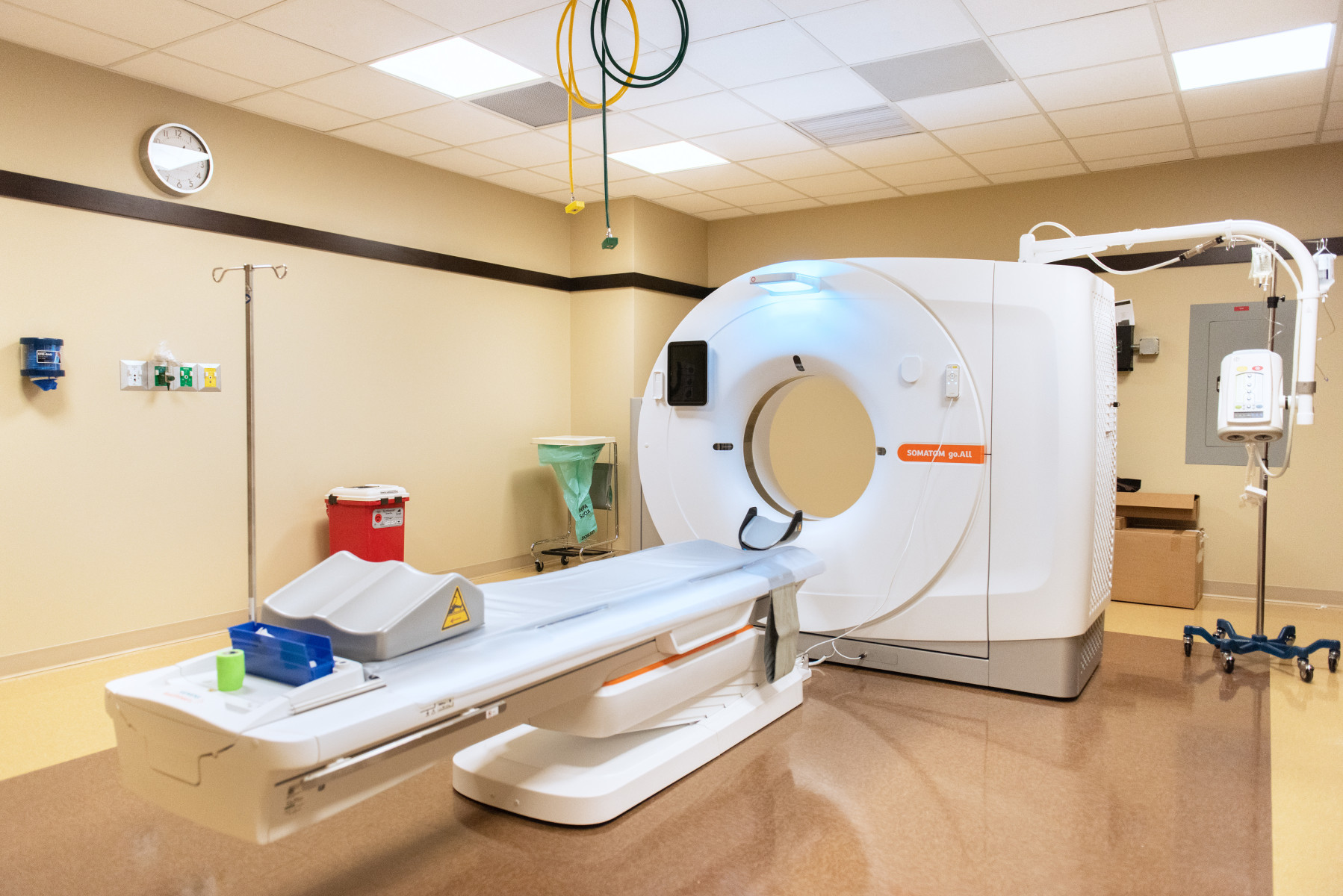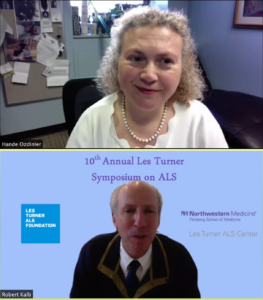
The 10th annual Les Turner Symposium on ALS —the first one held virtually — highlighted the ways Northwestern scientists and clinicians have continued their pursuit of knowledge and therapies for amyotrophic lateral sclerosis (ALS), featuring scientific presentations underlining the heterogeneity of the neurodegenerative disease, updates on innovative clinical trials and a question-and-answer session for patients and caretakers.
The symposium, held November 9, was and sponsored by the Les Turner ALS Center at Northwestern Medicine, which unites all ALS basic science, clinical investigation and patient care efforts under one umbrella. The Les Turner ALS Foundation, one of the country’s oldest independent ALS organizations, established the center.
“We ensure that each person living with the disease receives the best quality care and access to promising therapies,” said Andrea Pauls Backman, MBA, chief executive officer of the Les Turner ALS Foundation. “As the longest-serving independent ALS group in the country, our approach has not changed.”
Sabrina Paganoni, MD, PhD, assistant professor of Physical Medicine and Rehabilitation at Harvard Medical School gave the keynote address. Paganoni outlined the HEALEY ALS Platform Trial, of which she is a co-principal investigator, highlighting the adaptive trial protocols that are intended to speed up drug development.
One feature of the trial is a platform approach: it offers three different interventions that are tested independently alongside a single control group. Sharing placebo data across different drug regimens allows scientists to make meaningful comparisons while minimizing the number of patients who receive the placebo, Paganoni said.
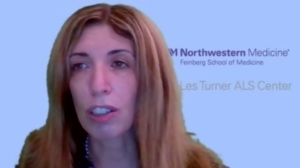
“This criteria gives us the best shot at being able to answer the question of if these drugs work in a relatively short period of time, while also having a patient-centric approach,” Paganoni said.
Other scientists — from Feinberg and from across the country — presented recent scientific discoveries and updates on ongoing efforts to understand basic mechanisms of ALS and find therapies. Robert Kalb, PhD, director of the Les Turner ALS Center and the Joan and Paul Rubschlager Professor, outlined his efforts to improve glycolysis in neurons affected by ALS.
Glycolysis, a metabolic process that helps produce energy for the cells, is often dysfunctional in neurons affected by ALS. Kalb has discovered two genes involved in glycolysis that when disabled, improve the process overall.
“When you lose these genes, there is less flux in these side pathways and more substrate going through the glycolysis pathway,” said Kalb, who is also chief of Neuromuscular Disease in the in the Ken and Ruth Davee Department of Neurology. “The loss of these two genes had a broad pro-metabolic effect: we were excited about that.”
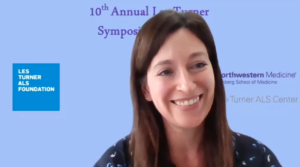
Tania Gendron, PhD, assistant professor of Neuroscience at Mayo Clinic Jacksonville, spoke about her work examining disease differences between two genetic causes of ALS. While mutations in both C9ORF72 and SCA36 genes cause harmful proteins to accumulate in neurons, there are important differences that impact disease progression and treatment.
Namely, SCA36 disease exhibits chimeric proteins that are less soluble than the purer proteins in C9ORF72 disease — a testament to how different even relatively similar varieties of ALS can be.
“These chimeric proteins have altered solubility, and this could modify their toxicity,” Gendron said.
That heterogeneity was underlined by Evangelos Kiskinis, PhD, assistant professor of Neurology in the Division of Neuromuscular Disease. Kiskinis uses patient-derived stem cells to study ALS, and outlined three broad categories of pathology into which most ALS mutations fall: RNA metabolism, proteostasis and the cytoskeleton. However, one of the oldest and most well-studied genetic forms of ALS — a mutation in a gene called SOD1 — illustrates the cross-class nature of ALS pathology.
Kiskinis found that while SOD1 does not cause global defects in proteostasis, it produces major changes in a protein called VCP. Mutations alone in VCP have been linked to ALS, but this mechanism is different: SOD1 impacts how VCP interacts with other proteins, still ultimately causing changes in proteostasis.
“This shows the functional interaction between two different causes of ALS,” said Kiskinis, who is also an assistant professor of Physiology. “We’re beginning to illuminate the black box between mutant SOD1 and neurodegeneration.”
Another area of emerging importance is upper motor neurons. According to Pembe Hande Ozdinler, PhD, associate professor of Neurology in the Division of Neuromuscular Disease, these neurons are not properly integrated into the drug development pipeline.
“We assume that if a drug improves spinal motor neurons, upper motor neurons will also be improved,” Ozdinler said. “They are totally different neurons and for complex diseases such as ALS, we must understand how upper motor neurons are affected, as well.”
To that end, Ozdinler has modified several mouse models of genetic ALS with green fluorescent proteins that mark upper motor neurons. This simple strategy to incorporate upper motor neurons into the development pipeline could help further stratify patients by sub-population, matching patients to their most effective drugs.
“When you look on the microscope, the upper motor neurons are waving to you, ‘here I am,’” Ozdinler said. “When you test a drug, you can perfectly read if they are responding to the treatment or not.”
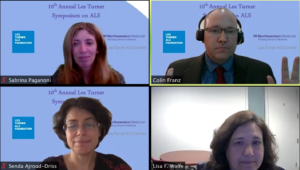
The final session of the symposium was a panel discussion, answering questions from the more than 300 people viewing the live-streamed event. Lisa Wolfe, MD, professor of Medicine in the Division of Pulmonary and Critical Care and in the Department of Neurology, touched on her work to ensure patient safety during the COVID-19 pandemic. Wolfe worked with Centers for Medicare and Medicaid to rewrite regulations on home spirometry, getting it approved for clinical trials.
“This will make a huge impact, not only on research but in what we are able to do clinically,” Wolfe said.
At the same time, many aspects of ALS clinical trials remain the same, including the steps people with ALS can take if they are interested in participating, according to Senda Ajroud-Driss, MD, ’05 GME, associate professor of Neurology in the Division of Neuromuscular Disease and director of the Lois Insolia ALS Clinic at Northwestern Medicine.
“The first place to start is with your physician or your neurologist,” Ajroud-Driss said. “Have a discussion about your disease stage and progression, and have an honest conversation about what’s next.”
Overall, the outlook on science and treatments for ALS is positive, Driss added.
“We are beginning to see the light at the end of the tunnel,” she said. “We are making progress with this disease.”




